The Activity Based Funding Model and Healthcare in Australia
VerifiedAdded on 2023/06/03
|8
|1624
|180
Report
AI Summary
This report provides an overview of the Activity Based Funding (ABF) model used in Australian public hospitals, highlighting its role in allocating funds based on the volume and complexity of services provided. It explains how the National Efficient Price (NEP), determined by the Independent Hospital Pricing Authority, is a core component of the ABF model and influences Commonwealth funding to hospitals. The report also discusses the autonomy granted to states in managing hospital funding and addressing the unique needs of their populations. While acknowledging criticisms regarding the weighting system used to determine the National Weighted Activity Unit (NWAU), the report concludes that ABF, with enhancements to the weighting formula, offers a framework for equitable resource allocation and responsiveness to population health needs, enabling both state and Commonwealth governments to address imbalances in the healthcare system. Desklib provides access to similar solved assignments for students.
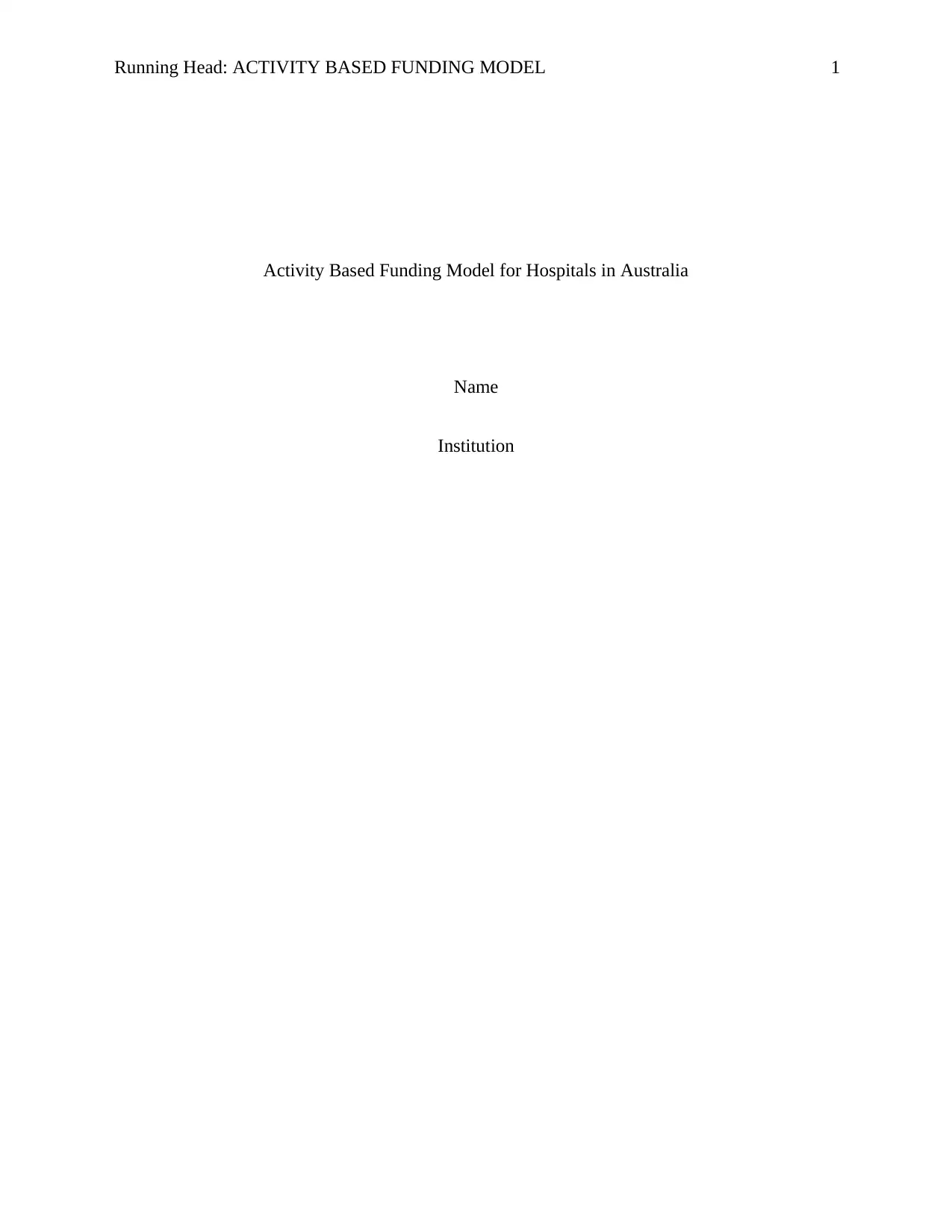
Running Head: ACTIVITY BASED FUNDING MODEL 1
Activity Based Funding Model for Hospitals in Australia
Name
Institution
Activity Based Funding Model for Hospitals in Australia
Name
Institution
Paraphrase This Document
Need a fresh take? Get an instant paraphrase of this document with our AI Paraphraser
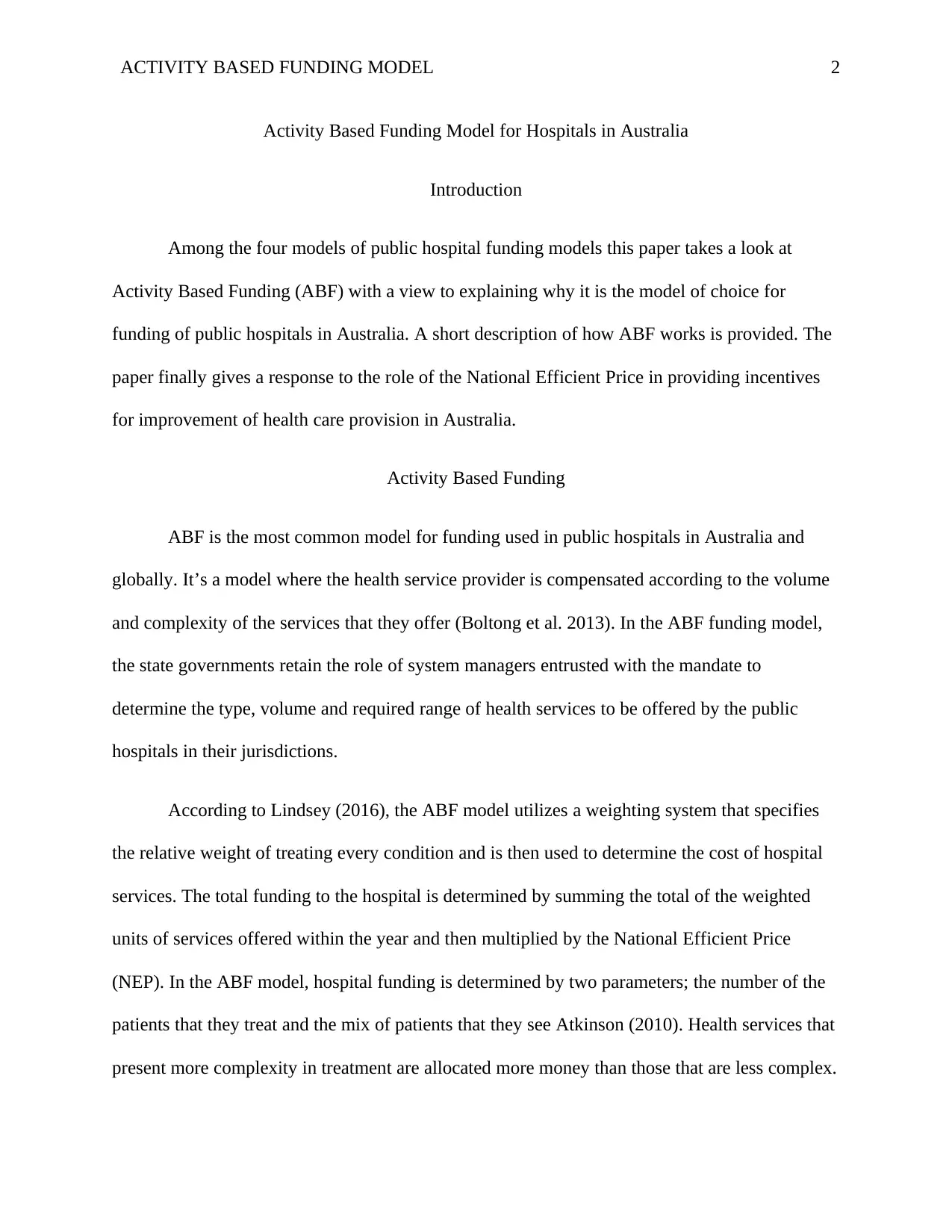
ACTIVITY BASED FUNDING MODEL 2
Activity Based Funding Model for Hospitals in Australia
Introduction
Among the four models of public hospital funding models this paper takes a look at
Activity Based Funding (ABF) with a view to explaining why it is the model of choice for
funding of public hospitals in Australia. A short description of how ABF works is provided. The
paper finally gives a response to the role of the National Efficient Price in providing incentives
for improvement of health care provision in Australia.
Activity Based Funding
ABF is the most common model for funding used in public hospitals in Australia and
globally. It’s a model where the health service provider is compensated according to the volume
and complexity of the services that they offer (Boltong et al. 2013). In the ABF funding model,
the state governments retain the role of system managers entrusted with the mandate to
determine the type, volume and required range of health services to be offered by the public
hospitals in their jurisdictions.
According to Lindsey (2016), the ABF model utilizes a weighting system that specifies
the relative weight of treating every condition and is then used to determine the cost of hospital
services. The total funding to the hospital is determined by summing the total of the weighted
units of services offered within the year and then multiplied by the National Efficient Price
(NEP). In the ABF model, hospital funding is determined by two parameters; the number of the
patients that they treat and the mix of patients that they see Atkinson (2010). Health services that
present more complexity in treatment are allocated more money than those that are less complex.
Activity Based Funding Model for Hospitals in Australia
Introduction
Among the four models of public hospital funding models this paper takes a look at
Activity Based Funding (ABF) with a view to explaining why it is the model of choice for
funding of public hospitals in Australia. A short description of how ABF works is provided. The
paper finally gives a response to the role of the National Efficient Price in providing incentives
for improvement of health care provision in Australia.
Activity Based Funding
ABF is the most common model for funding used in public hospitals in Australia and
globally. It’s a model where the health service provider is compensated according to the volume
and complexity of the services that they offer (Boltong et al. 2013). In the ABF funding model,
the state governments retain the role of system managers entrusted with the mandate to
determine the type, volume and required range of health services to be offered by the public
hospitals in their jurisdictions.
According to Lindsey (2016), the ABF model utilizes a weighting system that specifies
the relative weight of treating every condition and is then used to determine the cost of hospital
services. The total funding to the hospital is determined by summing the total of the weighted
units of services offered within the year and then multiplied by the National Efficient Price
(NEP). In the ABF model, hospital funding is determined by two parameters; the number of the
patients that they treat and the mix of patients that they see Atkinson (2010). Health services that
present more complexity in treatment are allocated more money than those that are less complex.
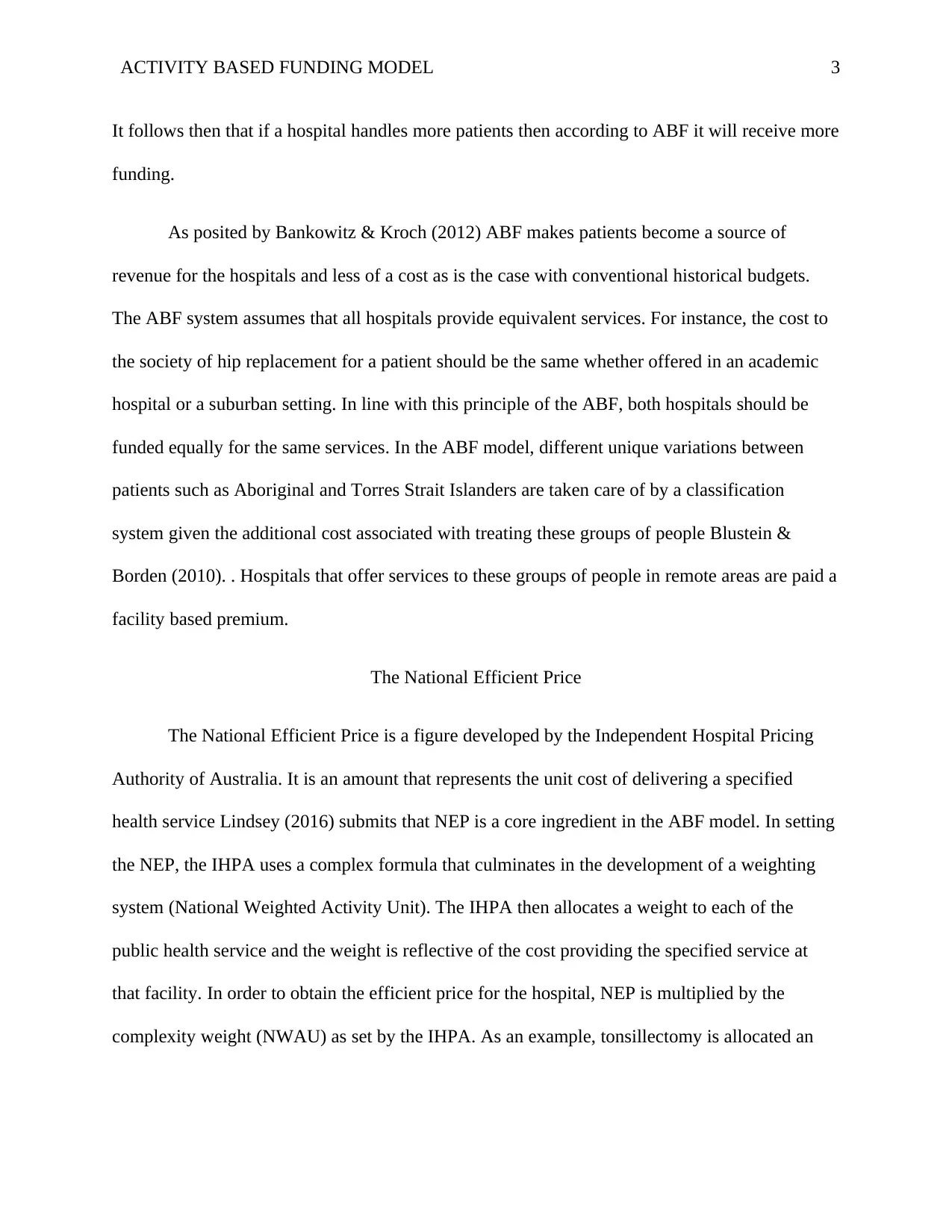
ACTIVITY BASED FUNDING MODEL 3
It follows then that if a hospital handles more patients then according to ABF it will receive more
funding.
As posited by Bankowitz & Kroch (2012) ABF makes patients become a source of
revenue for the hospitals and less of a cost as is the case with conventional historical budgets.
The ABF system assumes that all hospitals provide equivalent services. For instance, the cost to
the society of hip replacement for a patient should be the same whether offered in an academic
hospital or a suburban setting. In line with this principle of the ABF, both hospitals should be
funded equally for the same services. In the ABF model, different unique variations between
patients such as Aboriginal and Torres Strait Islanders are taken care of by a classification
system given the additional cost associated with treating these groups of people Blustein &
Borden (2010). . Hospitals that offer services to these groups of people in remote areas are paid a
facility based premium.
The National Efficient Price
The National Efficient Price is a figure developed by the Independent Hospital Pricing
Authority of Australia. It is an amount that represents the unit cost of delivering a specified
health service Lindsey (2016) submits that NEP is a core ingredient in the ABF model. In setting
the NEP, the IHPA uses a complex formula that culminates in the development of a weighting
system (National Weighted Activity Unit). The IHPA then allocates a weight to each of the
public health service and the weight is reflective of the cost providing the specified service at
that facility. In order to obtain the efficient price for the hospital, NEP is multiplied by the
complexity weight (NWAU) as set by the IHPA. As an example, tonsillectomy is allocated an
It follows then that if a hospital handles more patients then according to ABF it will receive more
funding.
As posited by Bankowitz & Kroch (2012) ABF makes patients become a source of
revenue for the hospitals and less of a cost as is the case with conventional historical budgets.
The ABF system assumes that all hospitals provide equivalent services. For instance, the cost to
the society of hip replacement for a patient should be the same whether offered in an academic
hospital or a suburban setting. In line with this principle of the ABF, both hospitals should be
funded equally for the same services. In the ABF model, different unique variations between
patients such as Aboriginal and Torres Strait Islanders are taken care of by a classification
system given the additional cost associated with treating these groups of people Blustein &
Borden (2010). . Hospitals that offer services to these groups of people in remote areas are paid a
facility based premium.
The National Efficient Price
The National Efficient Price is a figure developed by the Independent Hospital Pricing
Authority of Australia. It is an amount that represents the unit cost of delivering a specified
health service Lindsey (2016) submits that NEP is a core ingredient in the ABF model. In setting
the NEP, the IHPA uses a complex formula that culminates in the development of a weighting
system (National Weighted Activity Unit). The IHPA then allocates a weight to each of the
public health service and the weight is reflective of the cost providing the specified service at
that facility. In order to obtain the efficient price for the hospital, NEP is multiplied by the
complexity weight (NWAU) as set by the IHPA. As an example, tonsillectomy is allocated an
⊘ This is a preview!⊘
Do you want full access?
Subscribe today to unlock all pages.

Trusted by 1+ million students worldwide
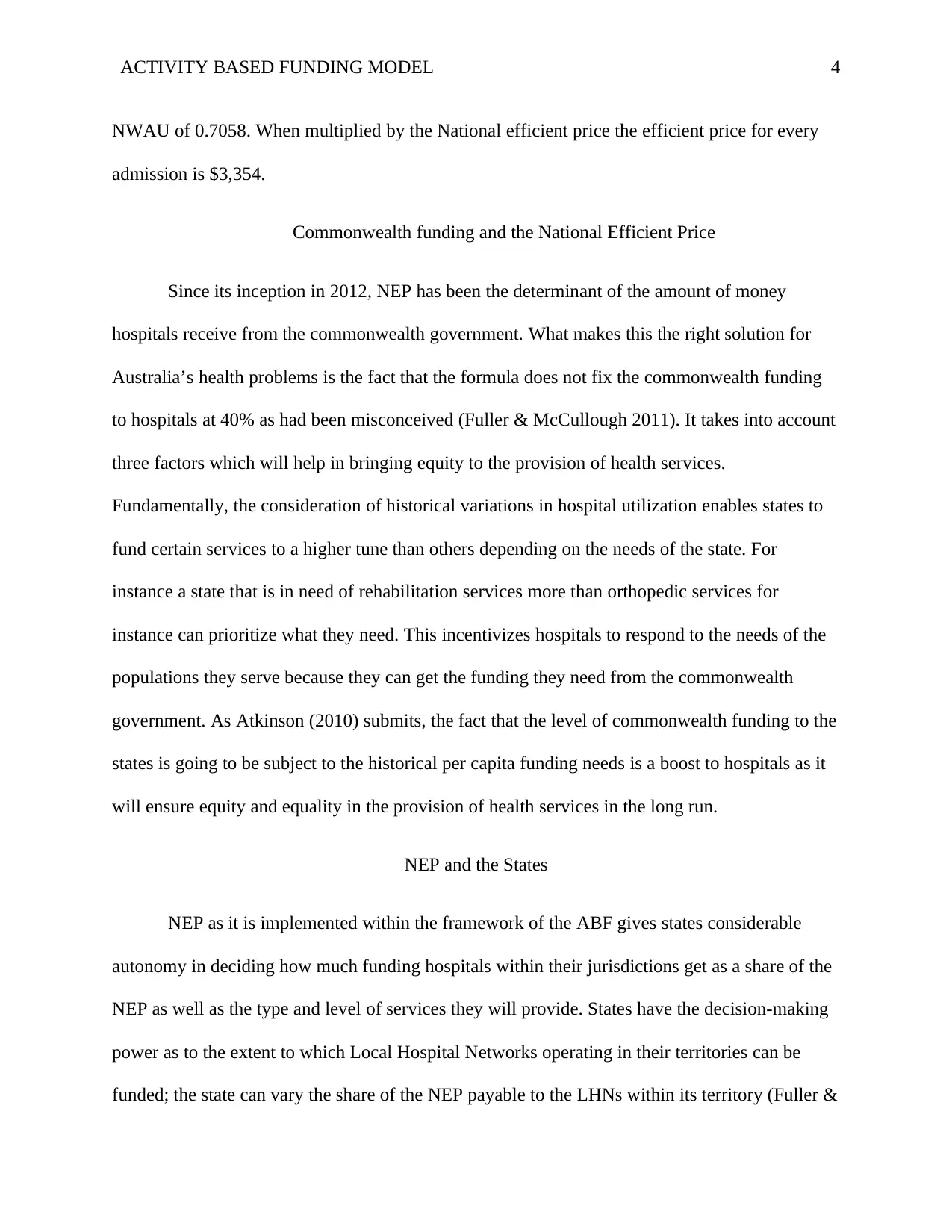
ACTIVITY BASED FUNDING MODEL 4
NWAU of 0.7058. When multiplied by the National efficient price the efficient price for every
admission is $3,354.
Commonwealth funding and the National Efficient Price
Since its inception in 2012, NEP has been the determinant of the amount of money
hospitals receive from the commonwealth government. What makes this the right solution for
Australia’s health problems is the fact that the formula does not fix the commonwealth funding
to hospitals at 40% as had been misconceived (Fuller & McCullough 2011). It takes into account
three factors which will help in bringing equity to the provision of health services.
Fundamentally, the consideration of historical variations in hospital utilization enables states to
fund certain services to a higher tune than others depending on the needs of the state. For
instance a state that is in need of rehabilitation services more than orthopedic services for
instance can prioritize what they need. This incentivizes hospitals to respond to the needs of the
populations they serve because they can get the funding they need from the commonwealth
government. As Atkinson (2010) submits, the fact that the level of commonwealth funding to the
states is going to be subject to the historical per capita funding needs is a boost to hospitals as it
will ensure equity and equality in the provision of health services in the long run.
NEP and the States
NEP as it is implemented within the framework of the ABF gives states considerable
autonomy in deciding how much funding hospitals within their jurisdictions get as a share of the
NEP as well as the type and level of services they will provide. States have the decision-making
power as to the extent to which Local Hospital Networks operating in their territories can be
funded; the state can vary the share of the NEP payable to the LHNs within its territory (Fuller &
NWAU of 0.7058. When multiplied by the National efficient price the efficient price for every
admission is $3,354.
Commonwealth funding and the National Efficient Price
Since its inception in 2012, NEP has been the determinant of the amount of money
hospitals receive from the commonwealth government. What makes this the right solution for
Australia’s health problems is the fact that the formula does not fix the commonwealth funding
to hospitals at 40% as had been misconceived (Fuller & McCullough 2011). It takes into account
three factors which will help in bringing equity to the provision of health services.
Fundamentally, the consideration of historical variations in hospital utilization enables states to
fund certain services to a higher tune than others depending on the needs of the state. For
instance a state that is in need of rehabilitation services more than orthopedic services for
instance can prioritize what they need. This incentivizes hospitals to respond to the needs of the
populations they serve because they can get the funding they need from the commonwealth
government. As Atkinson (2010) submits, the fact that the level of commonwealth funding to the
states is going to be subject to the historical per capita funding needs is a boost to hospitals as it
will ensure equity and equality in the provision of health services in the long run.
NEP and the States
NEP as it is implemented within the framework of the ABF gives states considerable
autonomy in deciding how much funding hospitals within their jurisdictions get as a share of the
NEP as well as the type and level of services they will provide. States have the decision-making
power as to the extent to which Local Hospital Networks operating in their territories can be
funded; the state can vary the share of the NEP payable to the LHNs within its territory (Fuller &
Paraphrase This Document
Need a fresh take? Get an instant paraphrase of this document with our AI Paraphraser
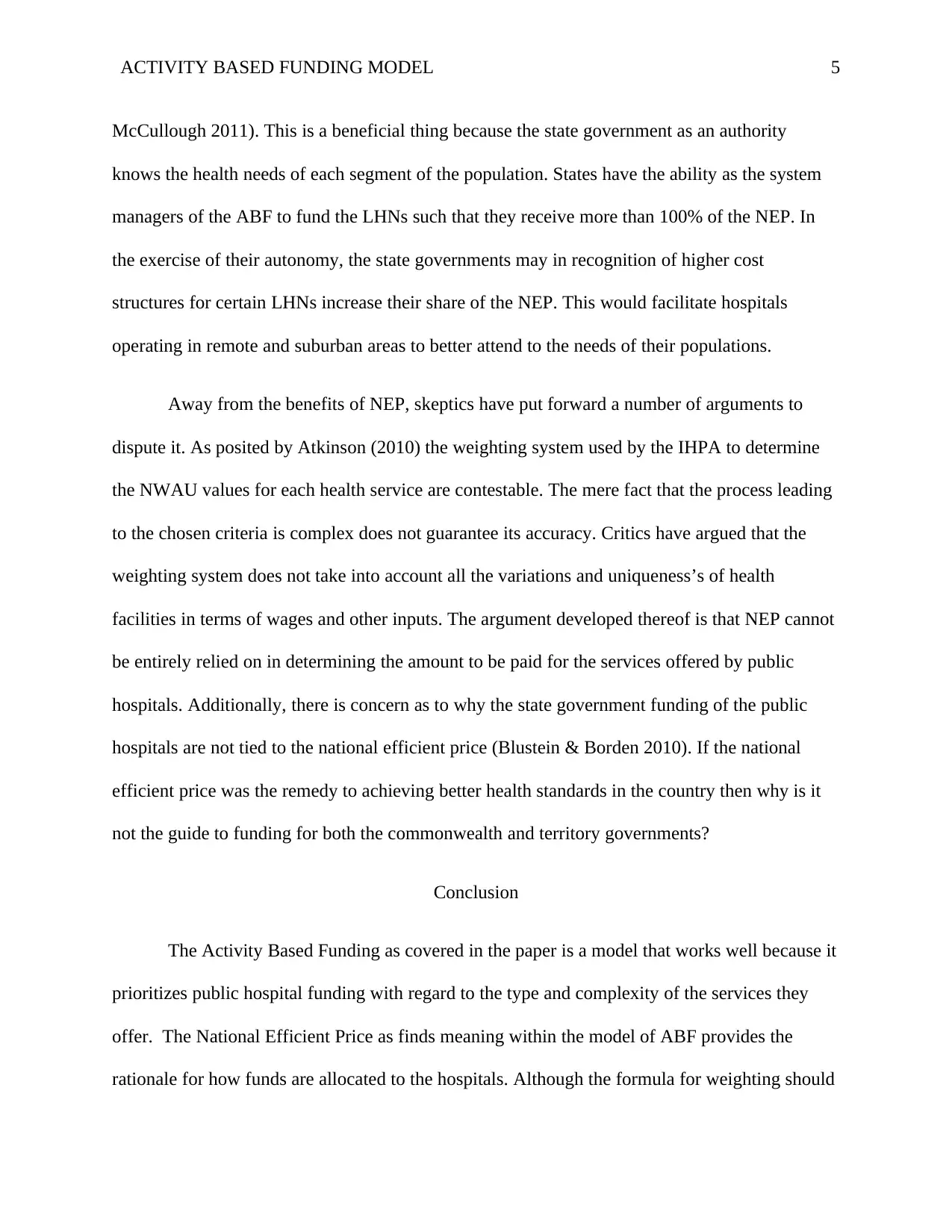
ACTIVITY BASED FUNDING MODEL 5
McCullough 2011). This is a beneficial thing because the state government as an authority
knows the health needs of each segment of the population. States have the ability as the system
managers of the ABF to fund the LHNs such that they receive more than 100% of the NEP. In
the exercise of their autonomy, the state governments may in recognition of higher cost
structures for certain LHNs increase their share of the NEP. This would facilitate hospitals
operating in remote and suburban areas to better attend to the needs of their populations.
Away from the benefits of NEP, skeptics have put forward a number of arguments to
dispute it. As posited by Atkinson (2010) the weighting system used by the IHPA to determine
the NWAU values for each health service are contestable. The mere fact that the process leading
to the chosen criteria is complex does not guarantee its accuracy. Critics have argued that the
weighting system does not take into account all the variations and uniqueness’s of health
facilities in terms of wages and other inputs. The argument developed thereof is that NEP cannot
be entirely relied on in determining the amount to be paid for the services offered by public
hospitals. Additionally, there is concern as to why the state government funding of the public
hospitals are not tied to the national efficient price (Blustein & Borden 2010). If the national
efficient price was the remedy to achieving better health standards in the country then why is it
not the guide to funding for both the commonwealth and territory governments?
Conclusion
The Activity Based Funding as covered in the paper is a model that works well because it
prioritizes public hospital funding with regard to the type and complexity of the services they
offer. The National Efficient Price as finds meaning within the model of ABF provides the
rationale for how funds are allocated to the hospitals. Although the formula for weighting should
McCullough 2011). This is a beneficial thing because the state government as an authority
knows the health needs of each segment of the population. States have the ability as the system
managers of the ABF to fund the LHNs such that they receive more than 100% of the NEP. In
the exercise of their autonomy, the state governments may in recognition of higher cost
structures for certain LHNs increase their share of the NEP. This would facilitate hospitals
operating in remote and suburban areas to better attend to the needs of their populations.
Away from the benefits of NEP, skeptics have put forward a number of arguments to
dispute it. As posited by Atkinson (2010) the weighting system used by the IHPA to determine
the NWAU values for each health service are contestable. The mere fact that the process leading
to the chosen criteria is complex does not guarantee its accuracy. Critics have argued that the
weighting system does not take into account all the variations and uniqueness’s of health
facilities in terms of wages and other inputs. The argument developed thereof is that NEP cannot
be entirely relied on in determining the amount to be paid for the services offered by public
hospitals. Additionally, there is concern as to why the state government funding of the public
hospitals are not tied to the national efficient price (Blustein & Borden 2010). If the national
efficient price was the remedy to achieving better health standards in the country then why is it
not the guide to funding for both the commonwealth and territory governments?
Conclusion
The Activity Based Funding as covered in the paper is a model that works well because it
prioritizes public hospital funding with regard to the type and complexity of the services they
offer. The National Efficient Price as finds meaning within the model of ABF provides the
rationale for how funds are allocated to the hospitals. Although the formula for weighting should

ACTIVITY BASED FUNDING MODEL 6
be enhanced, the NEP as it is gives room for state and commonwealth governments to correct the
imbalances of the health system in terms of funding and respond to the population’s health
needs.
be enhanced, the NEP as it is gives room for state and commonwealth governments to correct the
imbalances of the health system in terms of funding and respond to the population’s health
needs.
⊘ This is a preview!⊘
Do you want full access?
Subscribe today to unlock all pages.

Trusted by 1+ million students worldwide
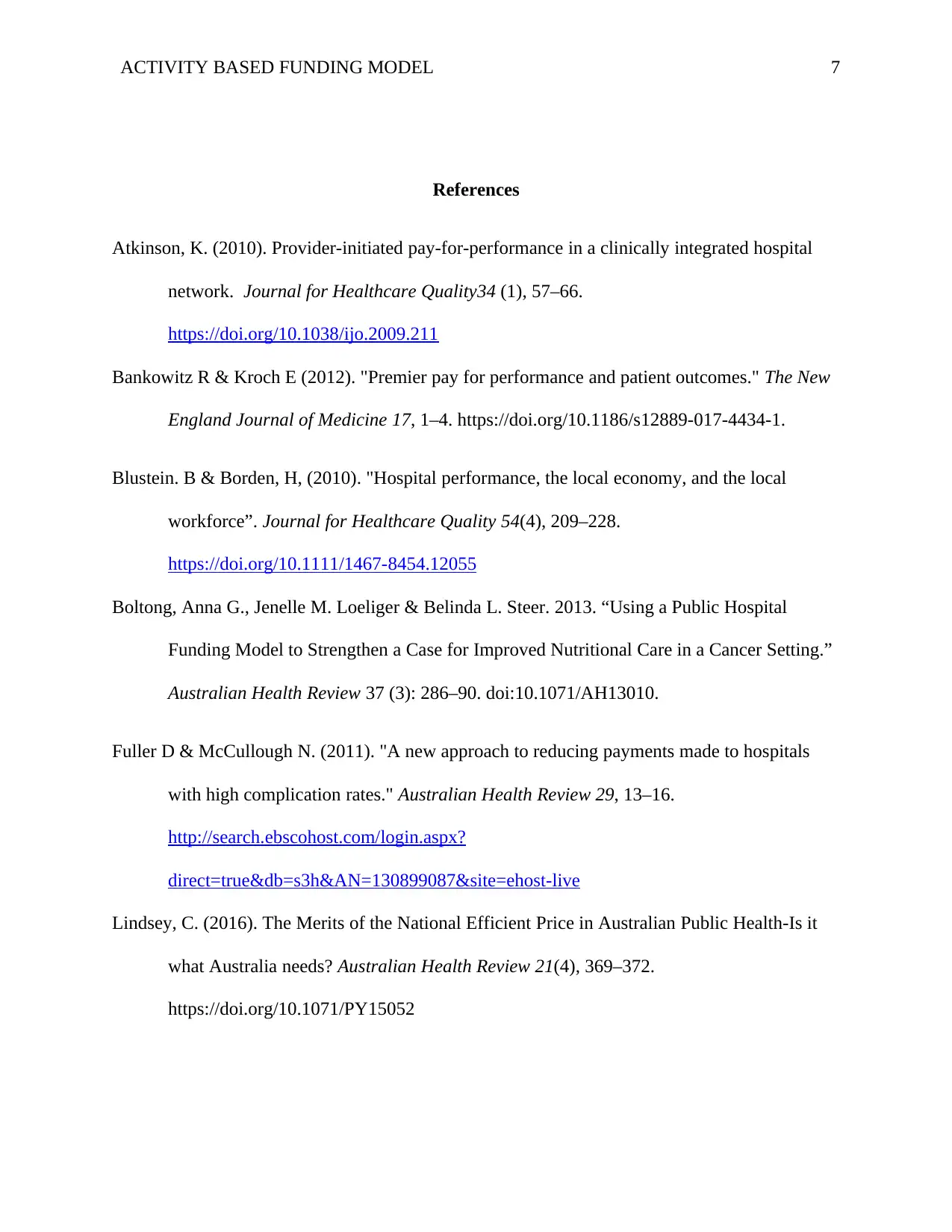
ACTIVITY BASED FUNDING MODEL 7
References
Atkinson, K. (2010). Provider-initiated pay-for-performance in a clinically integrated hospital
network. Journal for Healthcare Quality34 (1), 57–66.
https://doi.org/10.1038/ijo.2009.211
Bankowitz R & Kroch E (2012). "Premier pay for performance and patient outcomes." The New
England Journal of Medicine 17, 1–4. https://doi.org/10.1186/s12889-017-4434-1.
Blustein. B & Borden, H, (2010). "Hospital performance, the local economy, and the local
workforce”. Journal for Healthcare Quality 54(4), 209–228.
https://doi.org/10.1111/1467-8454.12055
Boltong, Anna G., Jenelle M. Loeliger & Belinda L. Steer. 2013. “Using a Public Hospital
Funding Model to Strengthen a Case for Improved Nutritional Care in a Cancer Setting.”
Australian Health Review 37 (3): 286–90. doi:10.1071/AH13010.
Fuller D & McCullough N. (2011). "A new approach to reducing payments made to hospitals
with high complication rates." Australian Health Review 29, 13–16.
http://search.ebscohost.com/login.aspx?
direct=true&db=s3h&AN=130899087&site=ehost-live
Lindsey, C. (2016). The Merits of the National Efficient Price in Australian Public Health-Is it
what Australia needs? Australian Health Review 21(4), 369–372.
https://doi.org/10.1071/PY15052
References
Atkinson, K. (2010). Provider-initiated pay-for-performance in a clinically integrated hospital
network. Journal for Healthcare Quality34 (1), 57–66.
https://doi.org/10.1038/ijo.2009.211
Bankowitz R & Kroch E (2012). "Premier pay for performance and patient outcomes." The New
England Journal of Medicine 17, 1–4. https://doi.org/10.1186/s12889-017-4434-1.
Blustein. B & Borden, H, (2010). "Hospital performance, the local economy, and the local
workforce”. Journal for Healthcare Quality 54(4), 209–228.
https://doi.org/10.1111/1467-8454.12055
Boltong, Anna G., Jenelle M. Loeliger & Belinda L. Steer. 2013. “Using a Public Hospital
Funding Model to Strengthen a Case for Improved Nutritional Care in a Cancer Setting.”
Australian Health Review 37 (3): 286–90. doi:10.1071/AH13010.
Fuller D & McCullough N. (2011). "A new approach to reducing payments made to hospitals
with high complication rates." Australian Health Review 29, 13–16.
http://search.ebscohost.com/login.aspx?
direct=true&db=s3h&AN=130899087&site=ehost-live
Lindsey, C. (2016). The Merits of the National Efficient Price in Australian Public Health-Is it
what Australia needs? Australian Health Review 21(4), 369–372.
https://doi.org/10.1071/PY15052
Paraphrase This Document
Need a fresh take? Get an instant paraphrase of this document with our AI Paraphraser

ACTIVITY BASED FUNDING MODEL 8
1 out of 8
Related Documents
Your All-in-One AI-Powered Toolkit for Academic Success.
+13062052269
info@desklib.com
Available 24*7 on WhatsApp / Email
![[object Object]](/_next/static/media/star-bottom.7253800d.svg)
Unlock your academic potential
Copyright © 2020–2025 A2Z Services. All Rights Reserved. Developed and managed by ZUCOL.




